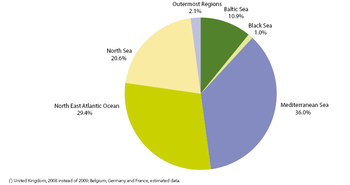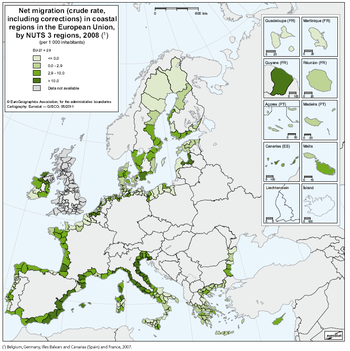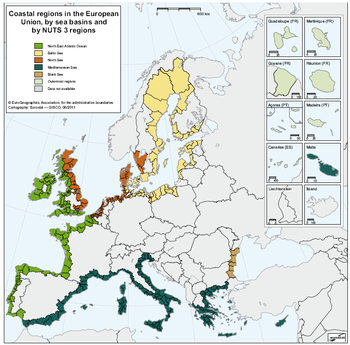- Data from March 2011, most recent data: Further Eurostat information, Main tables and Database.
This article brings together and analyses a wide range of official statistics available in the Eurostat database on the European Union (EU) coastal regions. A 'coastal region' is defined as a standard statistical region (at NUTS level 3) with either a sea border (83% of the 446 coastal regions) or at least half of its population within 50 km of the coast (17% of coastal regions) - to this grouping Hamburg is added because of its maritime character.
The coastal regions discussed belong to one of the 22 EU Coastal Member States, the Member States with a sea border: Belgium, Bulgaria, Denmark, Germany, Estonia, Ireland, Greece, Spain, France, Italy, Cyprus, Latvia, Lithuania, Malta, The Netherlands, Poland, Portugal, Romania, Slovenia, Finland, Sweden, and the United Kingdom.
The statistics collection presented in this article is not exhaustive, but a sample and illustration of how data from different statistical domains can be used in the context of the Integrated EU Maritime Policy.
Main statistical findings







EU coastal regions bordering the maritime basins
EU coastal regions belong to the 22 Member States that have a coastline. They are statistical regions defined at NUTS 3 level with a coastline or with more than half of their population living less than 50 km from the sea. These regions are distributed along oceans and seas bordering the EU coastline. As Map 1 shows, EU coastal regions border six main maritime basins: the Baltic Sea, the North Sea, the North East Atlantic Ocean, the Mediterranean Sea, the Black Sea and the outermost regions. However, the outermost coastal regions cannot be really considered as bordering a maritime basin. In these areas, the distance between the regions and their metropolis is the first criterion considered for this group.
Population of the EU coastal regions
In 2008, around 205 million people lived in the EU coastal regions, i.e. 41 % of the EU population or 44 % of the coastal Member States’ population. As Table 1 shows, the share of the national population living in a coastal region mainly depends on the geographical characteristics of a country, such as the length of the coastline and its configuration. For island states, such as Cyprus, or peninsulas such as Denmark, the share is 100 % because all regions in these countries are deemed to be coastal. At the other end of the scale, 2009 figures show the share of inhabitants of coastal regions was only 5 % in Romania and 9 % in Germany.
The EU population living along maritime basins
The most populated EU coastline is the Mediterranean. As Figure 1 shows, in 2009, the coastal regions bordering the Mediterranean housed 36 % of the EU coastal regions’ population, followed by the North East Atlantic Ocean coastal regions (30 %). This distribution is linked to the attractiveness of the area but is mainly impacted by geographic criteria, such as coast length and the number of coastal regions in each basin. In total, 142 EU coastal regions belong to the seven Member States bordering the Mediterranean Sea and only five EU coastal regions in Romania and Bulgaria border the Black Sea.
Structure of the EU coastal regions’ population by maritime basins
The structure of the EU coastal regions’ population by age and gender shows quite different profiles according to the maritime basin. Figure 2 shows the different basins’ age pyramids as compared with the age pyramid of the EU population as a whole.
Indeed, as clearly shown by the age pyramid of the EU outermost coastal regions, there was a greater share of people aged less than 40 years in these coastal regions than in the EU population as a whole. This is even more pronounced for people aged under 15 years. The structural difference is mainly due to the age structure of French overseas regions.
By contrast, the age pyramid of the EU coastal regions bordering the Baltic Sea shows an overrepresentation of people aged over 50 years as compared with the EU population as a whole.
The age pyramids also show a structural difference between the genders. In the EU coastal regions bordering the North Sea, there is an overrepresentation of the group including men aged over 40 years as compared with the EU population as a whole. Overrepresentation of this age group among women appears to be less pronounced.
The EU coastal regions population by maritime basins and urban–rural typology
The profile of the population living along the maritime basins also depends on the urban–rural type of the coastal regions bordering each basin. Indeed, the urban–rural type of the EU coastal regions has an impact on the kind of demographic pressure exerted on the coastal area and on socioeconomic issues. There has been a recent revision of urban–rural typology, taking into account the population density observed by grid cells of 1 km² and the population living in contiguous grid cell groups.
In 2009, as shown in Figure 3, 64 % of the population of EU coastal regions bordering the North Sea lived in predominantly urban regions. This is mainly due to the presence of large cities such as London, Hamburg and Rotterdam and the high population density in the Belgian, Dutch and German coastal regions.
By contrast, only 25 % of the population of EU coastal regions bordering the Baltic Sea lived in predominantly urban regions. Although these regions are home to major cities areas such as Copenhagen, Riga, Stockholm and Helsinki, the regions bordering this basin are predominantly rural, especially along the Finnish, Swedish and Estonian coastlines.
The population of EU coastal regions bordering the Black Sea lived in predominantly rural regions (12 %) or intermediate regions (88 %). None of the regions bordering this basin are considered to be predominantly urban. This is mainly a country effect as Romania and Bulgaria house few predominantly urban regions.
Geographic criteria also influence the distribution of the population in these regions. The fact that the majority (72 %) of the population of EU coastal outermost regions lived in predominantly urban regions is linked to the fact that these regions are quite small islands, mainly volcanic, and consequently housing space is limited.
Change in EU coastal regions’ population
In 2008, the population of the EU coastal regions increased by 0.6 % or 0.2 percentage points more than in the European Union as a whole. However, there were significant disparities between individual coastal regions and between coastal regions bordering each basin.
Population change or growth is the difference between the number of inhabitants in an area at the end and the beginning of a period. Relative population growth, evaluated here by the crude rate of population growth, has two components: natural population growth (balance between live births and deaths) and net migration. Map 2 showing the crude rate of population growth of the EU coastal regions in 2008 can be compared to Map 3 showing the crude rate of net migration of these regions in the same period.
In 2008, along the Mediterranean coastline, the crude rate of population growth was usually higher in the EU coastal regions of the western and central coast than in the east. This growth can be explained by net migration. The crude rates of population growth were higher in coastal regions such as the Spanish regions of Almería (27 ‰), the French region of Aude (11 ‰) or the Italian region of Viterbo (16 ‰) where net migration reached 20 ‰ in the region of Almería, 11 ‰ in the region of Aude and 18 ‰ in the region of Viterbo. By contrast, the crude rates of population growth were negative in the Greek region of Lakonia (– 6 ‰) partly explained by the crude rate of net migration (– 2 ‰) and in the Italian region of Napoli, where the crude rate of population growth (– 3‰) was deeply impacted by net migration (– 6 ‰). By contrast, in some regions, the trend in the crude rate of population growth went in the opposite direction to net migration, such as in the Greek region of Arkadia where the crude rate of population growth was – 5 ‰ despite a positive net migration (1 ‰).
Along the Black Sea coastline, in 2008, population changes in the coastal regions bordering this basin were rather more even. However, the crude rates of population change varied in the same way as net migration, such as in the Bulgarian coastal region of Varna, where the population grew by (8 ‰) due to net migration (8 ‰), and in the Romanian coastal region of Tulcea, where population growth was negative (– 6 ‰), reflecting net migration (– 3 ‰).
In 2008, along the North East Atlantic Ocean coastline, the crude rates of population growth were higher in the Irish coastal regions, such as in the Mid-East region (20 ‰) partly explained by net migration (6 ‰). The crude rates of population growth were also high along the west French coastline, such as in the region of Landes (11 ‰), explained by net migration (10 ‰), and in some Portuguese regions such as the region of Algarve (9 ‰), explained by net migration (8 ‰). By contrast, the crude rate of population growth was negative in the Portuguese region of Alentejo Litoral (– 7 ‰), partly due to net migration (– 2 ‰). The Spanish region of Lugo bucked this trend with a negative crude rate of population growth (– 4 ‰) despite positive net migration (4 ‰).
Along the North Sea coastline, the highest crude rates of population growth were in the English, Belgian and Dutch regions, partly explained by net migration in Belgium and the Netherlands. By contrast, the negative crude rate of population growth in the German regions is also partly due to net migration. However, during this period, in the Dutch region of Delfzijl en omgeving, the crude rate of population growth was negative (– 15‰), explained by net migration (– 14 ‰), and growth in the German region of Hamburg was positive (9 ‰), also due to net migration (9 ‰).
In 2008, along the Baltic Sea coastline, the highest crude rates of population growth were mainly in the predominantly urban regions, such as the Finnish region of Uusimaa (12 ‰), partly explained by net migration (7 ‰), the Swedish region of Stockholms län (16 ‰), partly due to net migration (10 ‰), and the Latvian region of Pieriga (13 ‰), due to net migration (14‰).
In 2008, population changes in outermost coastal regions were mixed. In the Spanish coastal region of Gran Canaria, population growth was 13 ‰, mainly due to net migration (10 ‰). By contrast, in the French coastal region of Guadeloupe, population growth was 6 ‰, despite a net migration of – 3 ‰.
As Map 4 shows, in 2009, the share of women in the EU coastal regions population was fairly even. Along the Baltic Sea coastline, the share of women in the Swedish and Finnish coastal regions was below the EU average, but it was above average in the Latvian, Estonian and Lithuanian coastal regions.
In the same period, along the Mediterranean coastline, there was also a contrast between the Spanish and Greek coastal regions, which had a lower female population, and the French and north Italian coastal regions, which had a higher female population.
The North Atlantic Ocean Spanish coastal regions had a higher share of women than the Mediterranean coastline, and as compared with the EU average.
Active population of the EU coastal regions
In 2009, the active population of the EU coastal regions was around 97 million persons, i.e. 41 % of the whole EU active population. In general, the active population grew in the EU coastal regions faster than in the EU. However, the rise in active population differed greatly between countries. Between 2007 and 2009, as Table 13.2 shows, the active population in Germany remained fairly stable, rising from 3 652 000 persons to 3 669 000 persons, giving a 0.2 % average annual growth rate. During the same period, the active population of Malta increased by an annual average rate of 2.1 %.


In 2009, the share of women in the active population of the EU coastal regions varied from 33.7 % in Malta to 50.5 % in Latvia. In general, as Map 5 shows, the share of women in the active population of the EU coastal regions along the Mediterranean and Black Sea basins was lower than the EU average, except for the Mediterranean French regions and the Spanish region of Barcelona. By contrast, the share was higher than the EU average in the EU coastal regions along the Baltic Sea. The share of women in the active population was more varied in the EU coastal regions along the other maritime basins.
Unemployment in EU coastal regions
In 2009, as shown in Map 6, the risk of unemployment in the EU coastal regions was no higher than the national average. In 53 % of EU coastal regions, unemployment was lower than the national average. In general, proximity to the sea was not a discriminatory factor. Thus, in the southern and the Mediterranean coastal regions of Spain, the active population was more exposed to unemployment. This was also the case for the southern Italian coastal regions, eastern German coastal regions and French and Spanish outermost coastal regions. By contrast, the majority of the active population of the coastal regions along the North East Atlantic Ocean was less exposed to unemployment.
Female unemployment in EU coastal regions
In 2009, as shown in Map 7, the female active population was at greater risk of unemployment, in particular in the coastal regions along the southern coastlines of France, Spain and Italy, several Greek regions and in the French and Spanish coastal outermost regions. Female unemployment rates can be compared to the share of women in the active population illustrated in Map 5. In the coastal regions along the southern Italian coastline and in several Greek coastal regions, the share of women in the active population was below the EU average and female unemployment was higher than the EU average. By contrast, in the Swedish and Finish coastal regions, the share of women in the active population was above the EU average and female unemployment was below the EU average.
Data sources and availability
EU coastal regions: a coastal region of the European Union is a statistical region defined at NUTS level 3 of the geographical nomenclature that has a coastline or more than half of its population living less than 50 km from the sea. The EU has 446 such regions, belonging to the 22 Member States which have a coastline. Of these 446 coastal regions, 372 have a coastline, while 73 meet the second criterion. Lastly, the German region of Hamburg has been added to the list, given the strong influence of the sea there. The 22 Member States which have a coastline are: Belgium, Bulgaria, Denmark, Germany, Estonia, Ireland, Greece, Spain, France, Italy, Cyprus, Latvia, Lithuania, Malta, the Netherlands, Poland, Portugal, Romania, Slovenia, Finland, Sweden and the United Kingdom.
Context
On 10 October 2007, the Commission adopted the Blue Paper launching an integrated maritime policy for the European Union. The aims of this policy are to maximise the sustainable use of oceans and seas, enhance Europe’s knowledge and innovation potential in maritime affairs, ensure development and sustainable growth in coastal regions, strengthen Europe’s maritime leadership and raise the profile of maritime Europe. This policy stresses the importance of coastal regions due to their geographic location and aims to develop sea basin strategies.
Further Eurostat information
Publications
- Agricultural statistics - Main results 2008-09 - Pocketbook
- Nearly half of the population of EU countries with a sea border is located in coastal regions09 - Statistics in Focus 47/20
- Portrait of EU coastal regions - Statistics in focus 38/2010
- Regional yearbook 2011 - Chapter 13 - Coastal regions
Main tables
- Regional statistics (t_reg)
- Regional agriculture statistics (t_reg_agr)
- Regional demographic statistics (t_reg_dem)
- Regional economic accounts - ESA95 (t_reg_eco)
- Regional tourism statistics (t_reg_tour)
- Regional transport statistics (t_reg_tran)
- Regional labour market statistics (t_reg_lmk)
Database
- Regional statistics (reg)
- Regional agriculture statistics (reg_agr)
- Regional demographic statistics (reg_dem)
- Regional economic accounts - ESA95 (reg_eco)
- Regional tourism statistics (reg_tour)
- Regional transport statistics (reg_tran)
- Regional labour market statistics (reg_lmk)
- Regional migration statistics (reg_mig)
Methodology/Metadata
- Regional transport statistics (ESMS metadata file - reg_tran_esms)
- Regional migration statistics (ESMS metadata file - reg_mig_esms)
Source data for tables and graphs on this page (MS Excel)
 List of EU-22 coastal regions - NUTS3 codes and regions names
List of EU-22 coastal regions - NUTS3 codes and regions names


